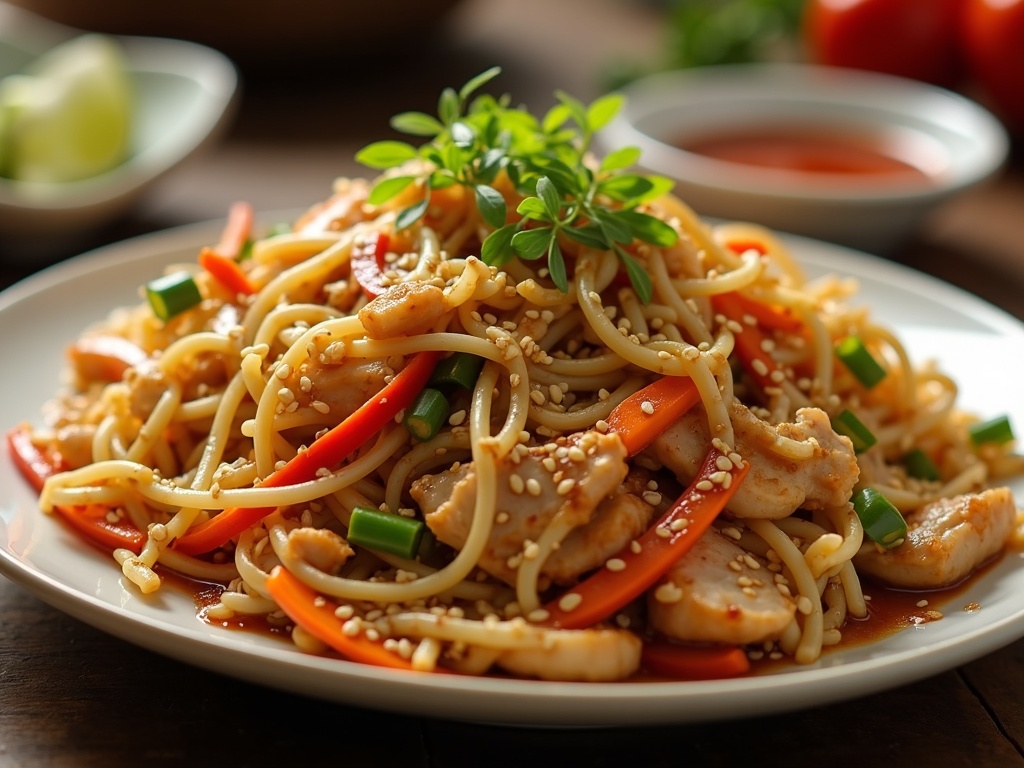Chicken chow mein recipe, a beloved Chinese stir-fry dish, combines tender chicken strips with crisp vegetables and flavorful noodles in a savory sauce that I’ve mastered making at home. With just a few quality ingredients and proper cooking techniques, I create a restaurant-quality version that balances protein, carbohydrates, and vegetables for a complete meal with approximately 350 calories per serving.
Find In This Article
Key Takeaways
- Use high heat and a staged cooking approach, adding ingredients in order of cooking time to maintain proper texture and develop authentic “wok hei” flavor.
- The foundation requires 2 boneless chicken breasts, 200 grams of chow mein noodles, and 2 cups of mixed vegetables like bell peppers, carrots, and bean sprouts.
- Marinate chicken for 30 minutes in soy sauce and rice wine before cooking, and blanch noodles until al dente to prevent them from becoming mushy.
- Homemade versions allow control over oil, sodium, and vegetable content, making them healthier than restaurant alternatives while still delivering authentic flavor.
- For restaurant-quality results, use premium ingredients like organic vegetables, free-range chicken, and high-quality soy sauce, garnishing with green onions and sesame seeds.
The Perfect Chicken Chow Mein Recipe: What You Need
Creating a delicious chicken chow mein at home is simpler than you might think. I’ve spent years perfecting this dish, and with the right ingredients, you’ll be able to make restaurant-quality chow mein in your own kitchen.
Essential Ingredients
The foundation of any good chicken chow mein starts with quality protein and noodles. For this recipe, you’ll need 2 boneless chicken breasts, which provide the perfect amount of lean protein. The chicken should be sliced into thin strips to ensure quick and even cooking.
The star of the dish is definitely the 200 grams of chow mein noodles, which serves 2-3 people comfortably. Look for fresh noodles if available, but dried ones work well too—just follow the package instructions for cooking time. These noodles have a wonderful texture that absorbs the savory sauce beautifully, similar to what you’d find in a good beef chow mein as well.
For vegetables, I recommend 2 cups of mixed vegetables including bell peppers, carrots, and bean sprouts. These provide color, crunch, and nutrition to your dish. Don’t be afraid to try seasonal vegetables for the best flavor and nutritional value. The freshness of these ingredients is what gives chicken chow mein its authentic taste.
Flavor comes from 3 cloves of minced garlic and soy sauce. The garlic should be fresh—not pre-minced from a jar—as it creates a more aromatic base. For the soy sauce, I suggest using a good quality brand that isn’t too salty, allowing you to control the overall seasoning of your dish.
Nutritional Benefits
One of the great things about homemade chicken chow mein is that you can enjoy a full, satisfying meal for around 350 calories per serving. This makes it a healthier alternative to many restaurant versions, which often contain hidden oils and excess sodium.
The balance of protein from the chicken, carbohydrates from the noodles, and fiber from the vegetables creates a well-rounded meal. This dish provides sustained energy without leaving you feeling heavy afterward, unlike some other noodle dishes.
If you’re looking to expand your Asian cuisine repertoire, the techniques used in this chicken chow mein can be applied to other classics like Chinese fried rice or even Pad Thai with just a few adjustments to the ingredients.
Fresh ingredients truly make a difference in this dish. While it might be tempting to use pre-cut frozen vegetables, the texture and flavor of fresh ones create that authentic restaurant-quality taste that’s hard to replicate otherwise. The crispness of just-cooked vegetables against the soft noodles and tender chicken creates that perfect textural contrast that makes chow mein so satisfying.
I’ve found that cutting all ingredients before starting to cook is essential—this dish comes together quickly once you start cooking, so having everything prepared helps maintain the perfect texture of each component. The chicken should be at room temperature before cooking to ensure even cooking throughout.
Remember that the key to great chicken chow mein isn’t just in the ingredients themselves, but in how they’re prepared and combined. With these quality components on hand, you’re already halfway to creating a memorable meal that might just become a regular in your dinner rotation.
Master the Essential Techniques
Creating authentic chicken chow mein isn’t complicated once you understand a few key techniques. The difference between a mediocre dish and restaurant-quality results comes down to proper preparation and cooking methods.
Perfect Your Preparation
First, I always marinate my chicken for 30 minutes in a mixture of soy sauce and rice wine. This simple step infuses the meat with flavor while tenderizing it. The marinade doesn’t need to be complex—just enough liquid to coat the chicken pieces evenly.
Proper noodle preparation is equally important. I blanch my chow mein noodles for just 2-3 minutes until they’re al dente, then immediately rinse them under cold water. This stops the cooking process and prevents them from becoming mushy when added to the wok later.
High heat is non-negotiable for authentic chow mein. The entire cooking process takes only 10-15 minutes once everything is prepped, but that heat needs to be consistently high. This quick cooking preserves the crispness of vegetables and prevents the noodles from becoming soggy.
The cooking order makes a significant difference in the final texture of your dish:
- Start by cooking the chicken separately until just done
- Remove chicken and set aside
- Stir-fry aromatics like garlic and ginger
- Add harder vegetables first, followed by softer ones
- Return chicken to the wok
- Add noodles and sauce last, tossing quickly to combine
I strongly recommend using a wok if possible. Its rounded shape allows for even heat distribution and creates that distinctive ‘wok hei’ flavor—the slightly smoky essence that defines great chow mein. If you don’t have a wok, a large skillet will work, but you might miss some of that authentic flavor.
Pre-cooking the chicken separately ensures it stays tender and doesn’t overcook while you’re dealing with the other ingredients. This technique is also useful when preparing other Asian noodle dishes like pad thai or Chinese fried rice.
With these techniques mastered, you’ll be able to create chicken chow mein that rivals your favorite restaurant’s version—perhaps even better since you can customize it exactly to your taste!
Creating the Perfect Balance of Flavors
The art of making delicious chicken chow mein lies in balancing flavors and textures. I’ve found that careful timing and technique create that authentic taste that rivals your favorite Chinese restaurant.
Layered Cooking Approach
I start by adding vegetables in stages based on their cooking times. Firmer vegetables like carrots and broccoli go in first, followed by quick-cooking ones like bean sprouts and green onions. This staged approach ensures each vegetable reaches its ideal texture – tender but still crisp.
Once the vegetables reach the right consistency, I add the pre-cooked chicken back to the wok. This prevents the chicken from drying out while allowing it to absorb the developing flavors. The key is to keep everything moving in the wok with high heat to lock in flavors without overcooking.
The noodles always go in last after they’ve been briefly soaked or boiled. Adding them at the end prevents them from becoming soggy or sticking together in clumps. I quickly toss them with the chicken and vegetables, allowing them to pick up all those amazing flavors.
Mastering the Sauce and Heat
Maintaining high heat throughout the cooking process is crucial for authentic chow mein flavor. This intense heat creates what Chinese cooking calls ‘wok hei’ – that smoky, charred essence that’s the hallmark of great stir-fry dishes.
The sauce needs careful attention too. I use soy sauce as the foundation but apply it with restraint. Too much makes the dish overly salty; too little leaves it bland. I often complement it with a touch of oyster sauce for depth and a hint of sesame oil for an aromatic finish.
For additional flavor complexity, I sometimes include:
- A splash of chicken broth for depth
- A pinch of white pepper for subtle heat
- A dash of rice vinegar for brightness
- A sprinkle of sugar to balance the saltiness
This balanced approach to flavors pairs perfectly with other Asian favorites like Chinese fried rice or even pad Thai for a complete feast. The goal is creating harmony between the tender chicken, crisp vegetables, soft noodles, and savory sauce – each bite should deliver a perfect combination of all elements.
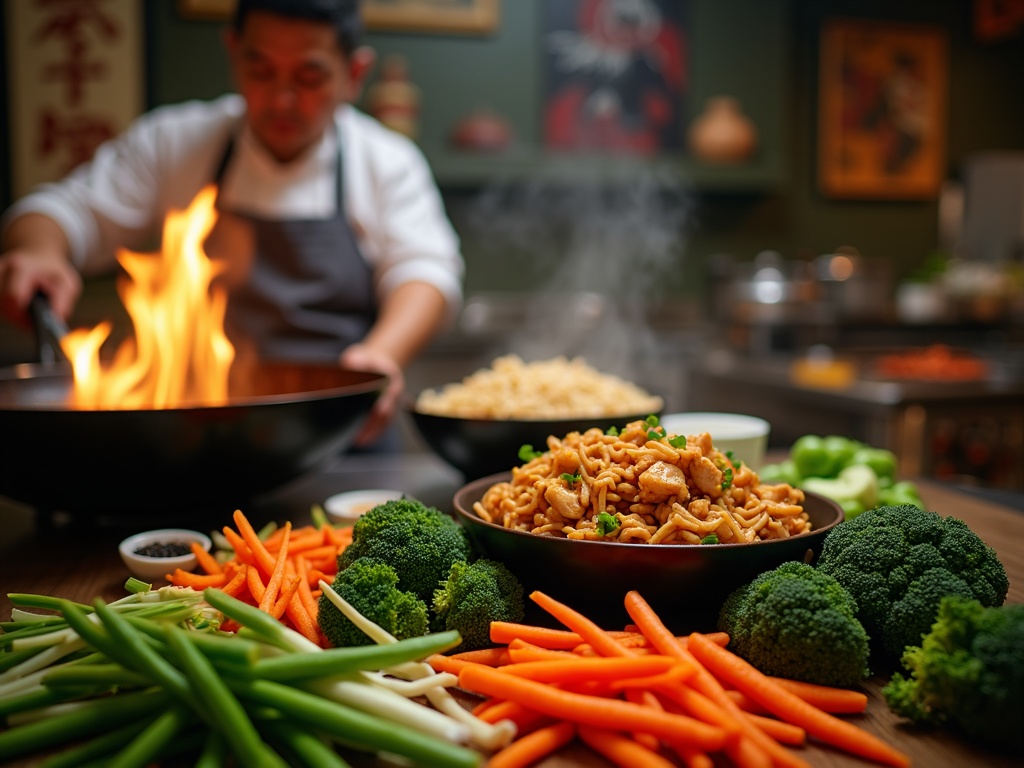
Nutrition and Health Benefits
Making homemade chicken chow mein gives me complete control over what goes into my meal. Each serving contains approximately 350 calories, making it a relatively light dinner option that still satisfies my hunger. I’ve found this dish to be nutritionally balanced with 25g of protein from the chicken, 45g of carbohydrates from the noodles, and 10g of fat from the cooking oil.
Nutritional Advantages Over Takeout
When I prepare chicken chow mein at home rather than ordering takeout, I notice significant health benefits. Restaurant versions often contain hidden calories from excessive oil and sodium that I can easily reduce in my kitchen. The homemade version allows me to:
- Control the amount of oil used in cooking
- Adjust sodium levels by reducing soy sauce or using low-sodium alternatives
- Add extra vegetables for increased fiber and nutrients
- Choose leaner cuts of chicken for better protein quality
- Eliminate MSG and other additives commonly found in restaurant versions
I can also substitute ingredients based on dietary needs. Brown rice noodles can replace traditional egg noodles for added fiber, or I might use tamari instead of soy sauce for a gluten-free option.
A Complete Balanced Meal
What makes chicken chow mein particularly valuable nutritionally is how it combines all major food groups in a single dish. The chicken provides lean protein essential for muscle maintenance and growth. The noodles deliver complex carbohydrates for sustained energy. Vegetables add vital vitamins, minerals, and fiber.
I appreciate that I can easily customize the vegetable content based on what’s seasonal or already in my refrigerator. Adding colorful bell peppers increases vitamin C, while dark leafy greens like bok choy boost calcium and iron intake. For additional variety and nutritional benefits, I sometimes include bean sprouts for crunch and extra vitamin K.
Portion control becomes much easier with homemade chicken chow mein. I can serve myself an appropriate amount rather than finishing an oversized restaurant portion. This conscious approach to serving sizes helps maintain a healthy weight while still enjoying a satisfying meal.
The cooking method also contributes to the health profile of this dish. Stir-frying requires minimal oil while preserving nutrients that might be lost in other cooking methods. The quick cooking time retains more vitamins in the vegetables compared to longer cooking methods.
For those looking to explore other Asian-inspired dishes with similar nutritional benefits, beef chow mein offers a red meat alternative with comparable macronutrients. I’ve also found that Chinese fried rice can be adapted to be nutrition-focused by using brown rice and loading it with vegetables. For a different flavor profile but similar nutritional balance, pad thai combines protein, carbs, and vegetables in a harmonious way.
The beauty of chicken chow mein lies in its versatility – I can adjust ingredients based on my nutritional goals. Need more protein? I add extra chicken. Want to reduce carbs? I increase vegetables and decrease noodles. This flexibility makes it suitable for various dietary preferences while maintaining its essential character.
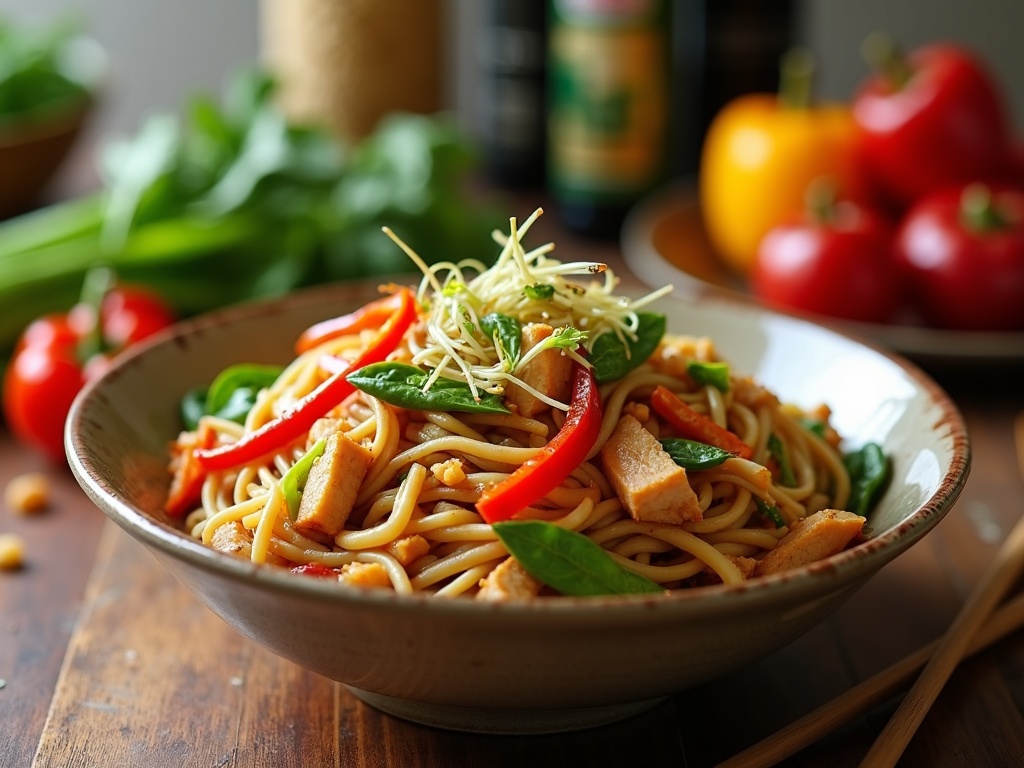
Make It Restaurant Quality
I’ve discovered that the difference between an average homemade chicken chow mein and a restaurant-quality dish comes down to a few simple but crucial elements. When I’m aiming to impress family or guests with an authentic experience, I pay special attention to ingredients and presentation.
Premium Ingredients Make All the Difference
The foundation of exceptional chicken chow mein starts at the market. I make it a point to source high-quality ingredients whenever possible. Local farmers’ markets often offer fresher produce than what you’d find in chain supermarkets, with vegetables harvested at peak ripeness.
When shopping for my chow mein ingredients, I prioritize:
- Organic vegetables when available, particularly for bell peppers, carrots, and bean sprouts
- Free-range chicken that hasn’t been injected with preservatives or excessive water
- Premium soy sauce brands like Lee Kum Kee or Pearl River Bridge, which offer deeper flavor than generic options
- Fresh noodles from Asian markets rather than dried varieties when possible
- Seasonal vegetables that bring optimal flavor and texture to the dish
The quality of soy sauce can’t be overstated in Chinese cooking. Lower-quality brands often contain excessive salt and artificial additives that can overpower the delicate balance of flavors. I’ve found that spending a few extra dollars on premium soy sauce transforms the entire dish.
Seasonal vegetables not only taste better but also provide superior texture. In summer, I might include snow peas and bell peppers, while winter calls for heartier options like broccoli and carrots. This approach creates variety in my Chinese cooking throughout the year.
The garnish provides both visual appeal and flavor enhancement. I always finish my chicken chow mein with finely sliced green onions and a light sprinkle of toasted sesame seeds. These final touches add fresh, aromatic notes and a subtle crunch that elevates the dish to restaurant standards.
Timing is another crucial factor. Unlike some dishes that benefit from resting, chow mein should be served immediately while piping hot. I heat my serving plates in a warm oven for about 5 minutes before plating, which keeps the noodles at the perfect temperature longer.
For an authentic experience, I serve my chicken chow mein with small ramekins of sweet and sour sauce on the side. This allows guests to adjust the flavor profile to their preference, just as they would in a restaurant setting.
The wok itself plays a significant role in achieving restaurant-quality results. I maintain a properly seasoned carbon steel wok that’s dedicated solely to Asian stir-fry dishes. The seasoned surface creates that distinctive “wok hei” flavor that’s nearly impossible to achieve with standard cookware.
When stir-frying, I work in small batches to maintain the high heat needed for proper caramelization. Overcrowding the wok causes ingredients to steam rather than sear, resulting in soggy vegetables and bland flavor. By cooking in batches and combining everything at the end, I maintain the integrity of each ingredient.
With these techniques and attention to quality, my homemade chicken chow mein consistently rivals what I’d find in a specialty restaurant—often at a fraction of the cost and with the satisfaction of having created it myself.
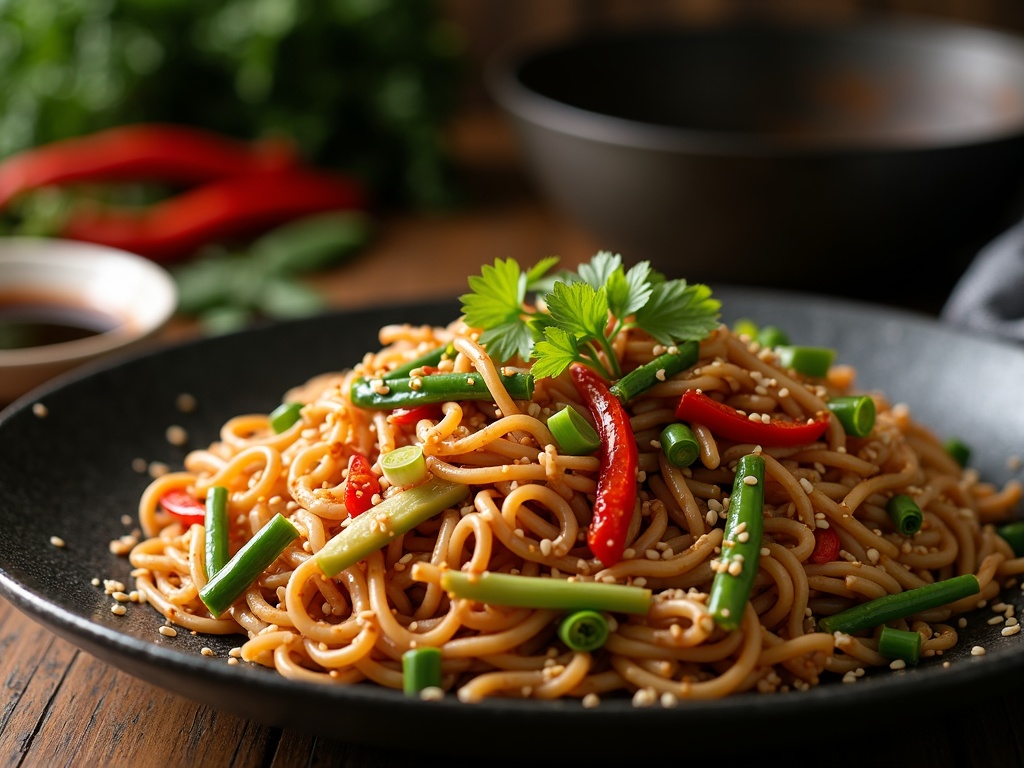
Elevate Your Presentation
I love how a few simple presentation touches can transform a homemade chicken chow mein from a casual weeknight meal into something truly special. The visual appeal of this classic dish matters almost as much as its taste. With just a few easy tweaks, I can make my chicken chow mein look as impressive as anything from a high-end Chinese restaurant.
Plating and Serving Suggestions
Serving chicken chow mein hot is absolutely essential for the best flavor experience. The noodles maintain their perfect texture, the vegetables stay crisp, and the sauce coats everything beautifully when it’s fresh from the wok. I always pre-warm my serving plates by placing them in a low oven (around 150°F) for a few minutes before plating. This simple step prevents the food from cooling too quickly and maintains that fresh-from-the-wok taste.
When arranging the dish, I create a small mound of noodles in the center of each plate, allowing the colorful vegetables and chicken pieces to be visible throughout. This creates an appetizing visual that highlights all the components of the dish. For family-style serving, I use a large, shallow bowl that showcases the vibrant colors and textures.
For a complete meal experience, I pair my chicken chow mein with spring rolls or egg rolls as appetizers. The contrast between the crispy exterior of the rolls and the tender chow mein creates a satisfying textural balance. This combination feels like an authentic Chinese restaurant experience right at home.
Fresh Garnishes and Accompaniments
The final touches make all the difference when presenting chicken chow mein. Here are my favorite ways to elevate the dish just before serving:
- Sprinkle toasted sesame seeds over the top for a nutty flavor and visual appeal
- Add thinly sliced green onions cut on a diagonal for freshness and color
- Include small wedges of lime on the side for guests to squeeze over their portion
- Scatter a few fresh bean sprouts on top for added crunch
- Add a small sprinkle of red pepper flakes for those who enjoy heat
I always add these garnishes right before serving to maintain their fresh appearance and crisp texture. The vibrant colors of the green onions against the golden noodles create an instantly appetizing presentation.
Offering condiments on the side allows everyone to customize their meal. I place small dishes of sweet and sour sauce, additional soy sauce, and sometimes chili oil on the table. These colorful accompaniments not only enhance the flavor but also add to the visual spread on the table.
For a complete Asian-inspired feast, I sometimes serve my chicken chow mein alongside Chinese fried rice or even a simple noodle dish for variety. The contrasting flavors and textures create a memorable dining experience that impresses guests without requiring excessive effort.
With these presentation techniques, my homemade chicken chow mein becomes much more than just a quick dinner—it transforms into a restaurant-quality meal that delights both the eyes and the palate.
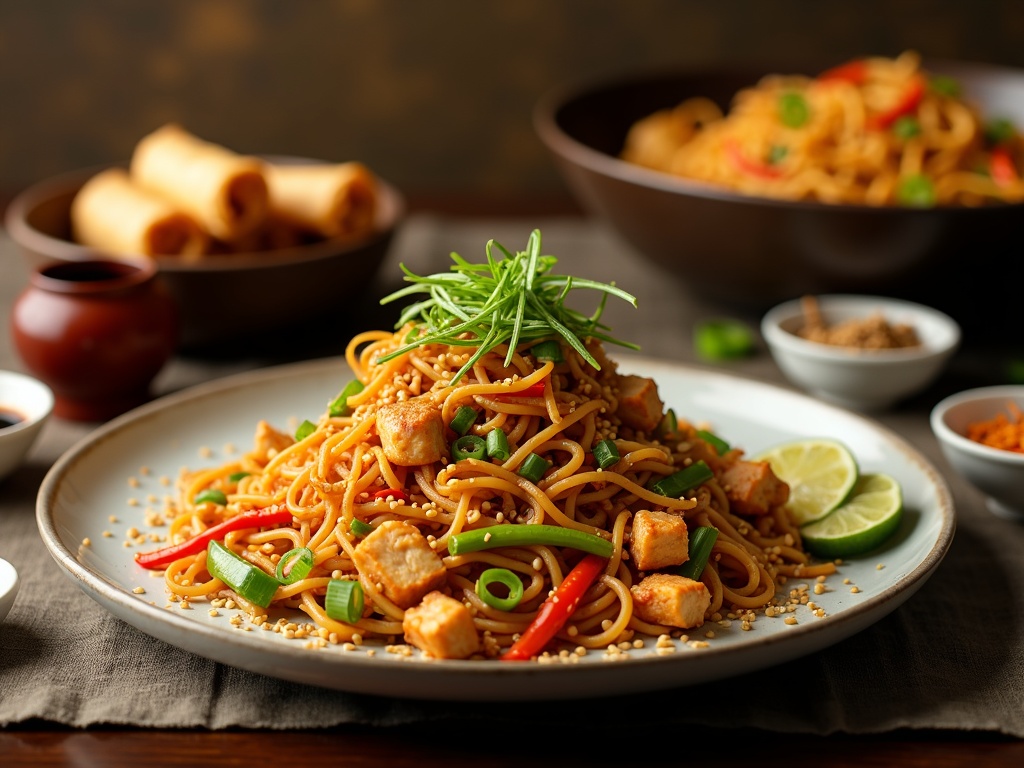
Sources:
A Guide to Chicken Chow Mein – Asian Cooking Magazine
The Nutritional Value of Chow Mein Dishes – Healthline
Understanding Stir-Frying Techniques – Cooking 101
Fresh Ingredients for Better Cooking – Local Foods Journal
Nutrition in Chinese Cuisine – Journal of Food Science

